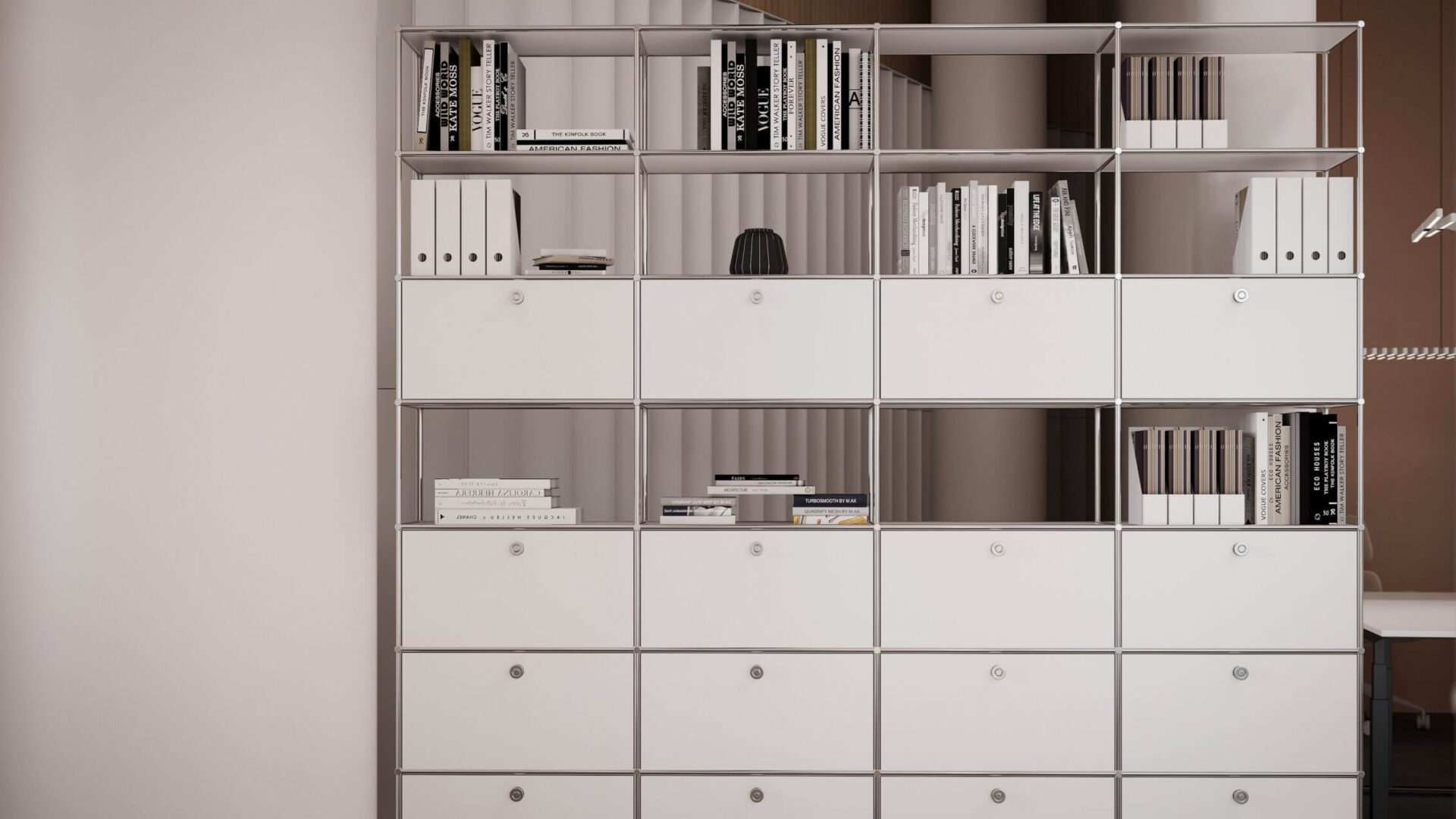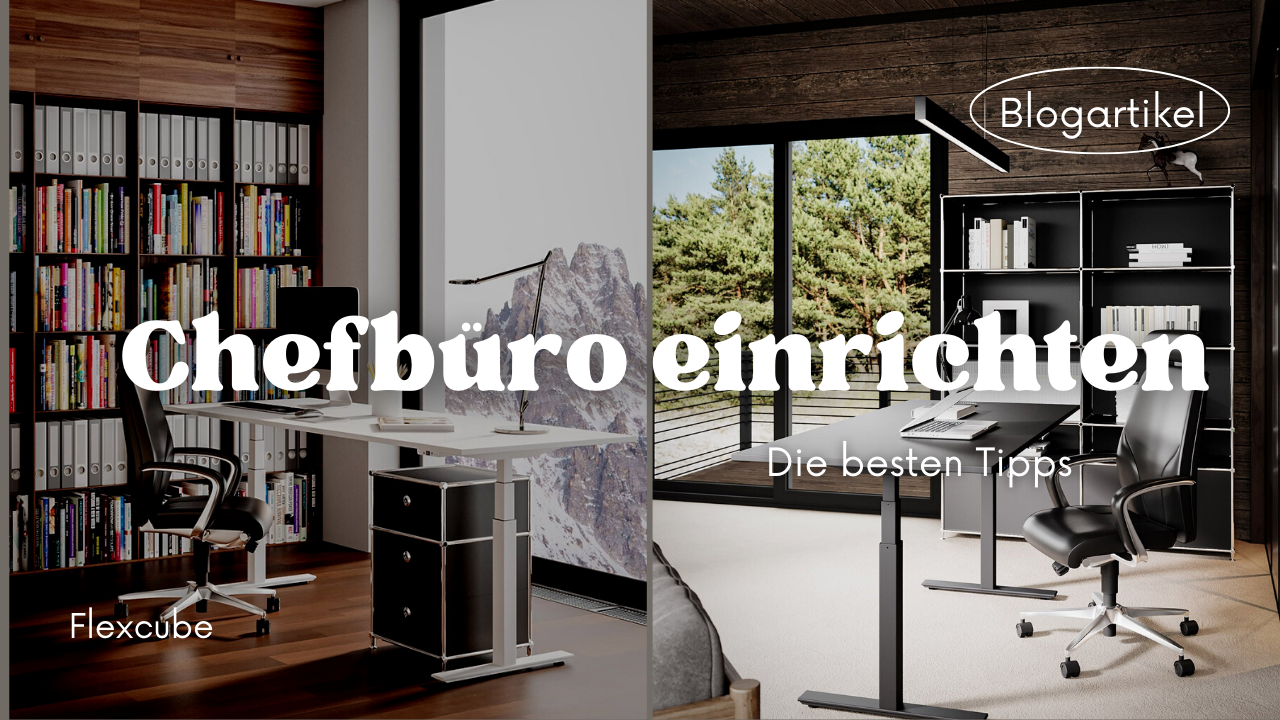When it comes to furnishing your office, there are a lot of things to consider. How can you make sure your employees are productive and enjoy their workplace? How do you want to work in your company? What kind of atmosphere do you want to create? In this blog post, we will discuss tips for effective office design. Read on and learn more!
Inhaltsverzeichnis
ToggleOffice furnishings: Why should you pay much attention to office decor?
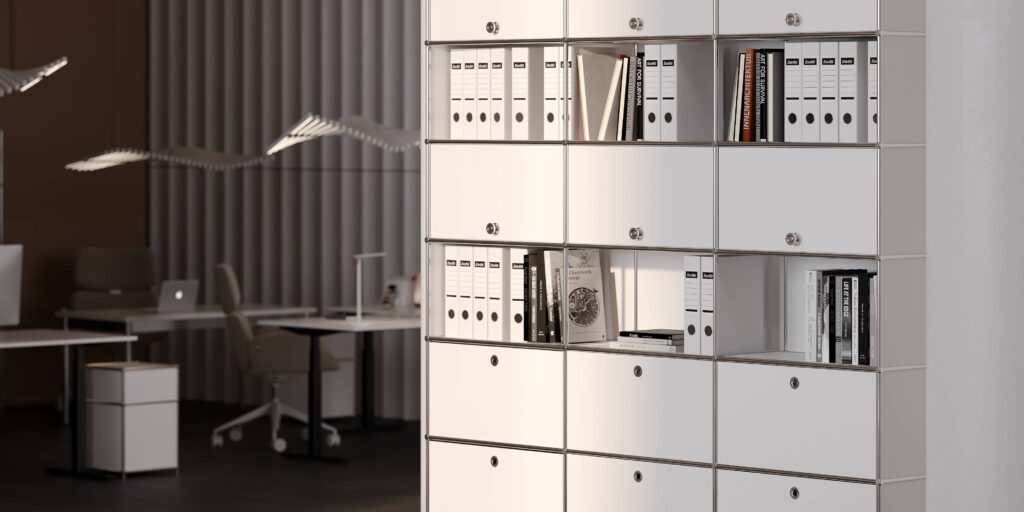
A needs-based work environment that takes into account the different needs of your employees is an important key to entrepreneurial success. Facilitate focused individual work, effective collaboration, networking, and communication through a work environment designed with them in mind. Thus, you create a pleasant and productive working environment in your office space.
How much space does a workplace need?
10m2 is a rough guide to the size required. Executive offices tend to be larger, while open-plan offices often require much smaller spaces per person.
In any case, it is necessary to comply with the legal requirements for the minimum size: at least 8sqm for the first workstation, at least 6sqm for each additional one.
How should the workstations be arranged?
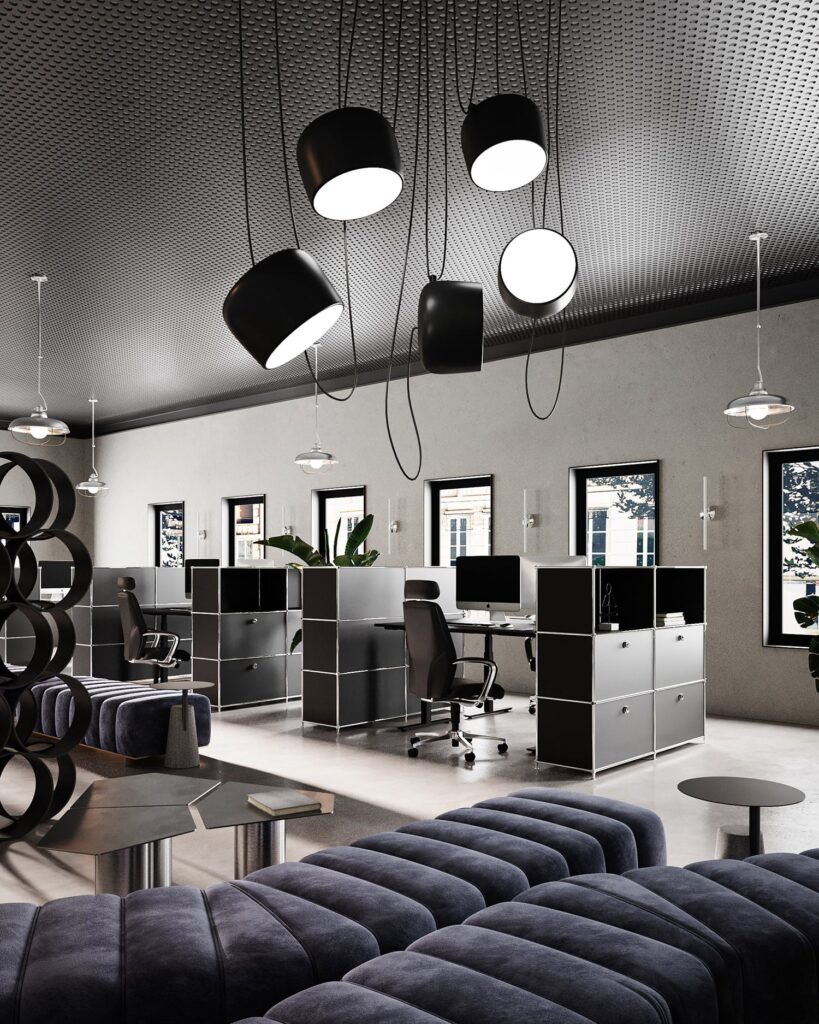
Workstations should be arranged so that employees can work as effectively and ergonomically as possible.
This means taking into account the 3 themes: Concentration, Collaboration and Communication to a special degree.
The following list gives you an overview of the most important points:
- Group by work tasks and workflows. In this way, you ensure “short paths of cooperation”.
- Place workstations vis-a-vis. Eye contact facilitates communication.
- Set up the workstations in such a way that work can be carried out as free of interference as possible. Where necessary, partition elements create the necessary privacy.
- Use natural daylight where possible. Place desks at 90 degrees to the window to avoid reflections in the screen.
- Do not place workstations with their backs to important walkways
- When setting up an office, it is also important to consider the technical equipment. Printers and copiers should be placed so that they are easily accessible. If possible in a central location to minimize walking distances.
Find the right office furniture
“Clothes make the man”. The same is true for your office furniture. It signals to your visitors, customers and employees what you and your company stand for. Many companies choose furniture with timeless elegant design that represents solidity, reliability and high quality standards.
In line with the corporate philosophy, opulently furnished offices or – e.g. for the budget-oriented startup – the purpose-oriented variant can of course also be found. Whatever path a company takes, the goal is always to create an environment that reflects its values and reinforces its brand identity. In today’s competitive market, office design is another way for businesses to stand out from the competition.
What does the term “ergonomics” mean in the workplace?

Ergonomics in the workplace is important for the health of employees. The main thing is to prevent back and neck pain and tension. Employees should be encouraged to change posture. You should work not only sitting, but also standing. A height-adjustable desk is ideal because it can be adjusted to the right height for each person.
An ergonomic office chair with good padding and lumbar support is also important to relieve back strain. If you are working with multiple monitors, you should also make sure that they are ergonomically positioned. The same goes for your keyboard and mouse.
Proper ergonomics in the workplace not only protects health, but also improves work performance. Employees are less tired and can concentrate better.
Want to learn more about ergonomics in the workplace?
The right office chairs
When it comes to ergonomic work, the right desk chair and its correct adaptation to the user is a top priority.
Learn more about the different functions and how to correctly adjust an office chair to the user here.
- Seat height, seat depth, seat tilt
The basis for optimal individual adjustment is the correct adaptation of the desk chair to body size and body proportions.
Seat height: You sit correctly when the hip, knee and foot joints are approximately at right angles. The thigh should form a line that slopes slightly toward the knee, so the knee should be slightly lower than your hip. Your feet are firmly planted on the floor.
Seat depth: You are sitting correctly when a distance of three to four fingers width remains between the front edge of the seat and your lower leg while your pelvis is touching the backrest.
Seat tilt: If your chair has this function, you can tilt the seat forward. Your pelvis is thus tilted slightly forward, which is good for the spine. - Armrests
You are sitting correctly when both shoulders are relaxed horizontally while your forearms rest on the armrests. - Backrest
Your back is optimally relieved when the lordosis support is at about the level of the waistline. - Neck support
A neck support relieves the cervical spine and the entire back. Relief option for the entire back. - Movement mechanics
Unfortunately, only very high-quality desk chairs have motion mechanics. Most chairs force a static working posture.
The even better alternative: change your working position frequently.
A height-adjustable desk provides you with optimal support. Here you can find more interesting information about how to properly adjust an office chair.
The right desks
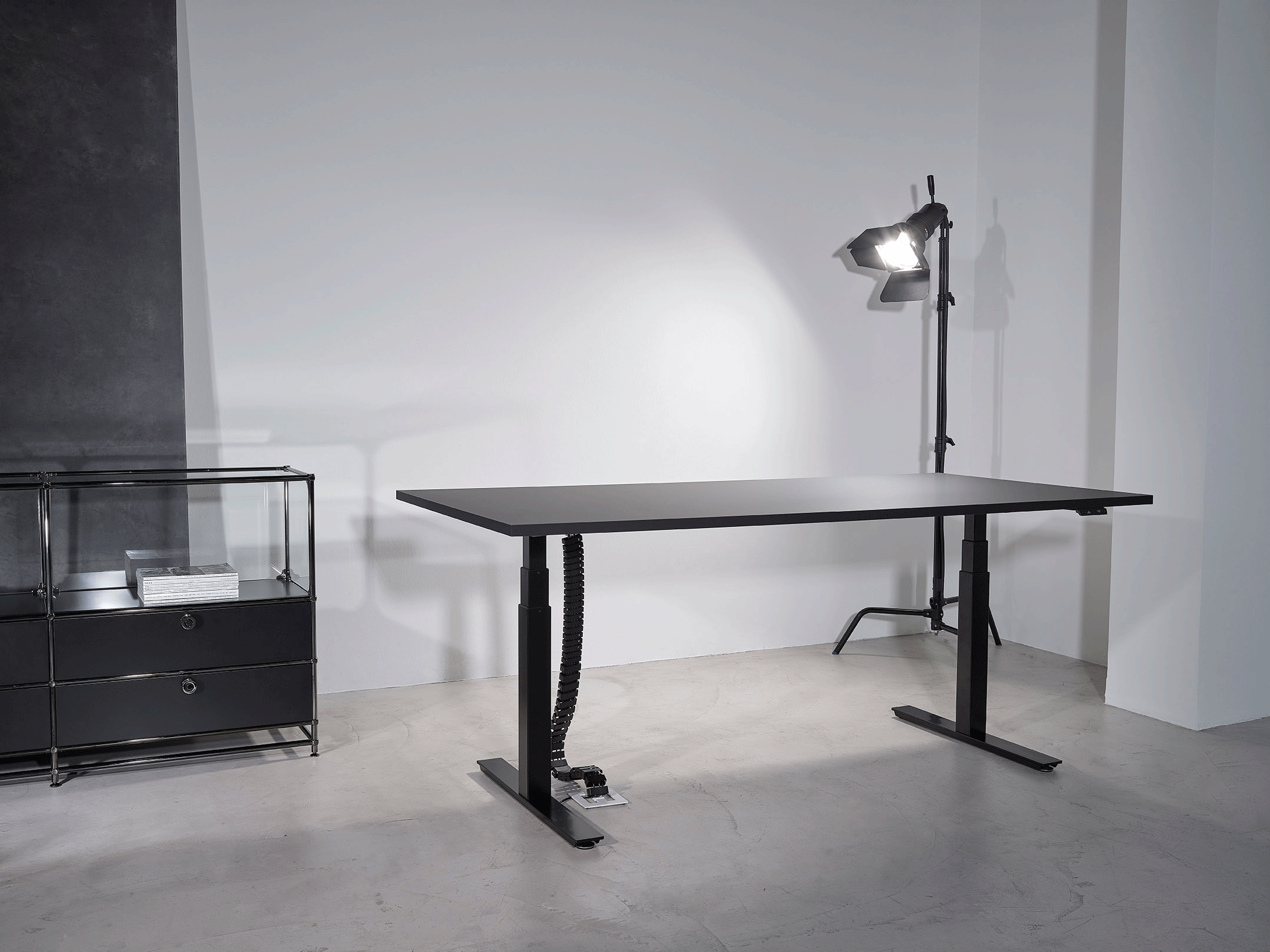
When it comes to furnishing your office, the desk is visually and functionally one of the most important pieces of furniture. After all, this is often where you spend most of your working life.
In an office with many departments and employees different desks will be appropriate, depending on different task contents. Here is an overview to help you choose a desk:
- Size
A standard desk is at least 160cm long and 80cm deep.
This size provides enough space for a monitor workstation and
storage space for documents.
For single offices, desks are preferably chosen in 180cm or 200cm length, if the room size allows.
If little space is needed for documents or screens, e.g. because most of the work is done on a laptop, 140x80cm is a good alternative size. - Height adjustability
More and more people are spending their working day sitting slightly bent over at the computer. This unhealthy posture quickly leads to tension in the neck/shoulder area. This pain can become chronic.
Therefore, we should change our working posture more often, instead of only sitting, we should also work standing up. With a height-adjustable desk, the change is very easy. - Storage space
You want your desk to look tidy? Then choose a model with integrated storage space or complement the desk, for example, with a drawer unit. - Cable management
In a modern workplace, many different cables quickly accumulate around the desk. A desk with integrated cable management helps minimize the risk of accidents and tripping. - Form
If a particularly large amount of space is required or a visitor function is to be integrated, an L-shaped desk is a popular choice.
Want to learn more about height adjustable desks?
Click here for our guide on height-adjustable desks
The right storage
Office furniture – your business card
It is recommended to choose office furniture with foresight. Your office space is not only a place to work, but also a place to represent. Choose office furniture that conveys your desired image.
Your business will change over time. New employees will be added, new work stations will have to be integrated. Choose furniture that can be adapted to changing requirements. This will allow your office space to look attractive and like new even after many years.
The entrance area
They say that the first impression is the most important. Therefore, make sure you make a positive first impression! A good reception area has a positive effect on visitors and employees.
A reception desk, coat rack, waiting or communication area with seating can provide the perfect entry point.
Sufficient storage space
Make it easy to keep order! If an office doesn’t have enough storage space, it quickly looks disorganized and unprofessional. Therefore, each workplace should include a cabinet for all frequently needed documents and files.
An untidy office does not generate a good impression, so plan sufficient storage space for office supplies and the archive.
What type of furniture for what kind of need?
There are many different types of storage, such as open or closed storage, high or low furniture, furniture on casters.
Open or closed storage?
Open storage is cheaper and more flexible, but it can quickly look untidy. With closed storage, their office can always look perfectly tidy. A variety of features allows you to choose the right furniture:
- Files disappear behind flaps
- Drawers store many small items
- Suspension files arrange a large number of files
- Drawer units combine storage in drawers and compartments directly at the desk.
High or low storage furniture?
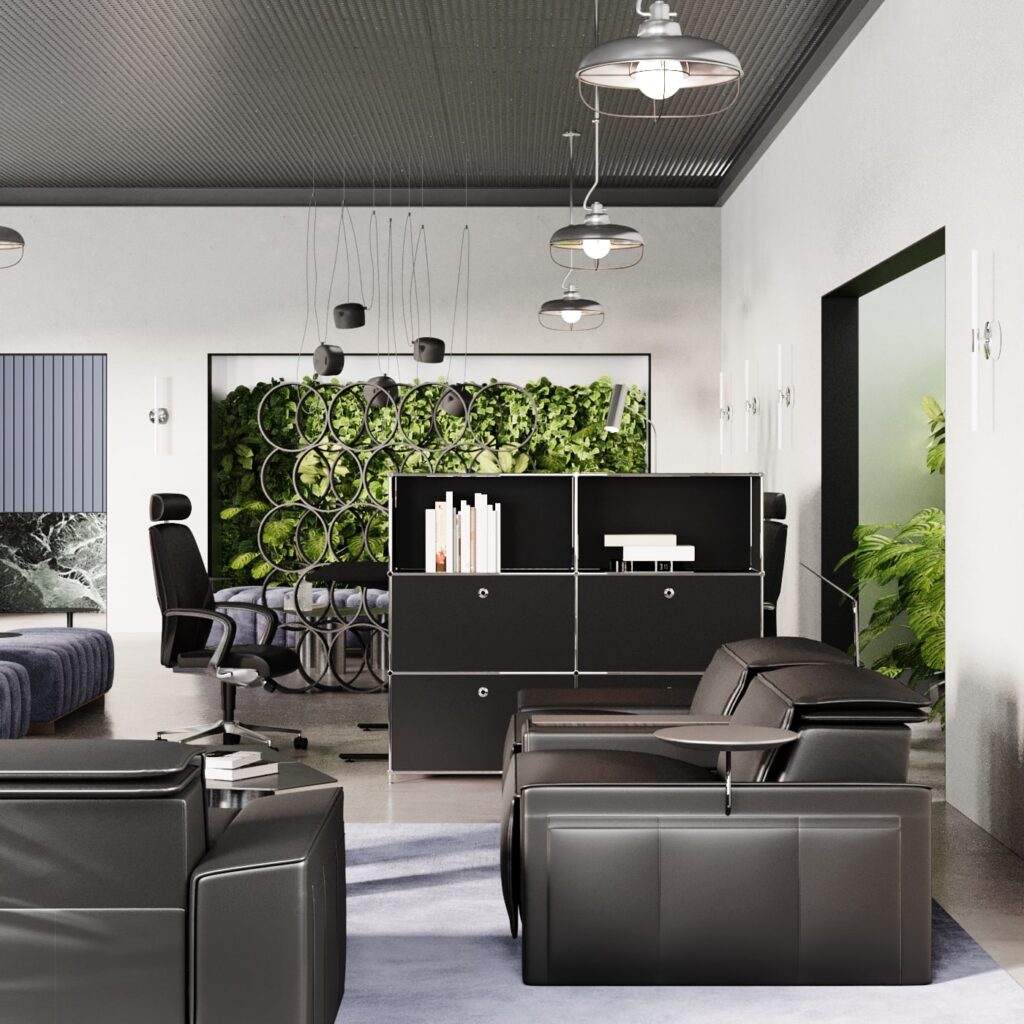
High storage uses m3 instead of just m2! In small offices, go cubic!
Use the entire wall height for storage. So you can store a lot in the smallest area.
High storage units can also be used as a room devider. High storage units help to smartly hide things away:
the printer and all its accessories, stationary or cleaning equipment can smartly be hidden behind an elegant furniture wall, without the hassle of having a real wall built in.
Lowboards or sideboards are also excellent for separating individual
workstations and areas without compromising the overview.
Modular furniture – the sustainable option

Modular furniture systems have the advantage of being changeable. They can be adapted to changing requirements at any time. They can be converted at any time: higher or lower. Longer or shorter. Open compartments can be supplemented with doors, flaps or drawers.
Individual parts can be replaced instead of disposing of entire pieces of furniture and starting from scratch. Quality and durability pay off in the long run. When your business is ready for a change, modular furniture will help you make the most of your new space.
What creates a pleasant atmosphere in the office?

Congratulations! With the previous steps, you have already set up your office space,
optimally tailored to your needs in terms of design and function. This could be the end of this blog, were it not for important aspects such as air, light and acoustics, which have a significant impact on everyday office life.
An office can be made inviting by many different things. Firstly, it is the right furniture and decoration. In addition, there is enough light and air circulation.
Colors
- Color structures and enlivens your office space
- In principle, large areas should be kept in subtle light colors. Single strong colors can be used as accents
Light and lighting
- Adequate basic lighting is essential for any office. Poor lighting strains the eyes and can lead to health problems.
- Office lighting should consist of a combination of direct and indirect general lighting. Direct lighting, such as task lights and desk lamps, provides focused light for specific tasks. Indirect lighting, such as ceiling lamps, emits diffused light that reduces glare and eye fatigue.
Acoustics
Unpleasant background noise is one of the biggest problems in open-plan offices. They can be minimized by clever planning of areas and workplaces. If they still occur, these simple tricks will help:
- Felt glides under fixed chairs
- Silent castors for office chairs
- Sound-absorbing materials (acoustic elements on walls)
- Soundproofing partition walls between workplaces
- Carpets and rugs in selected areas
Plants
Plants have a great impact on the atmosphere in an office. They do not only bring color and life to the office, but also play an important role in improving indoor air quality. In addition, plants can help reduce noise levels by absorbing sound waves
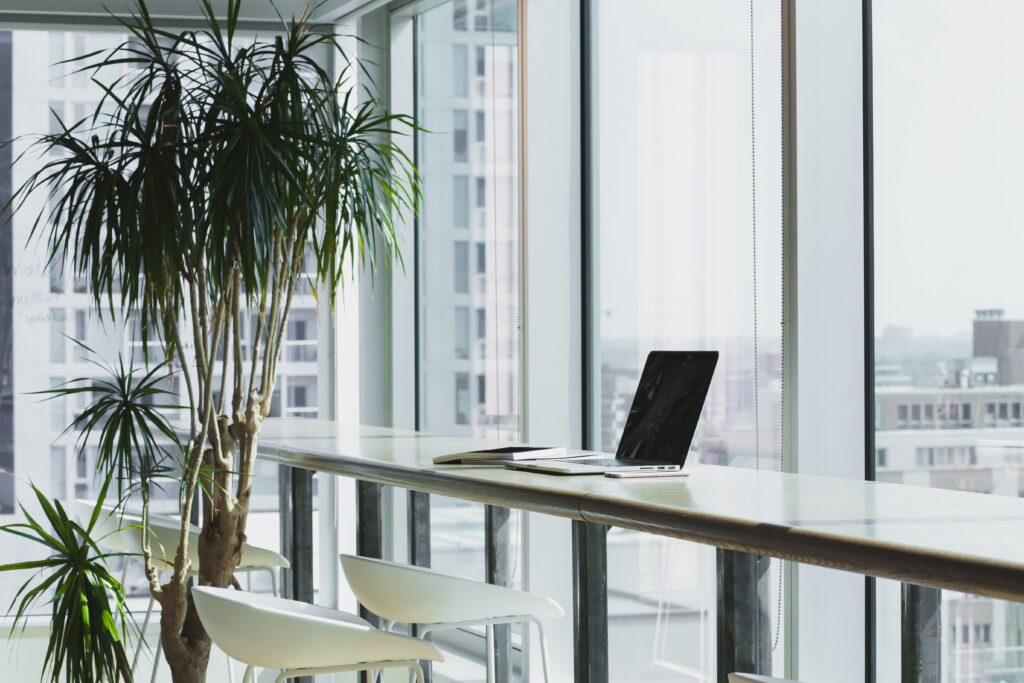
Office interior ideas
Here are some photos for your office and home office.
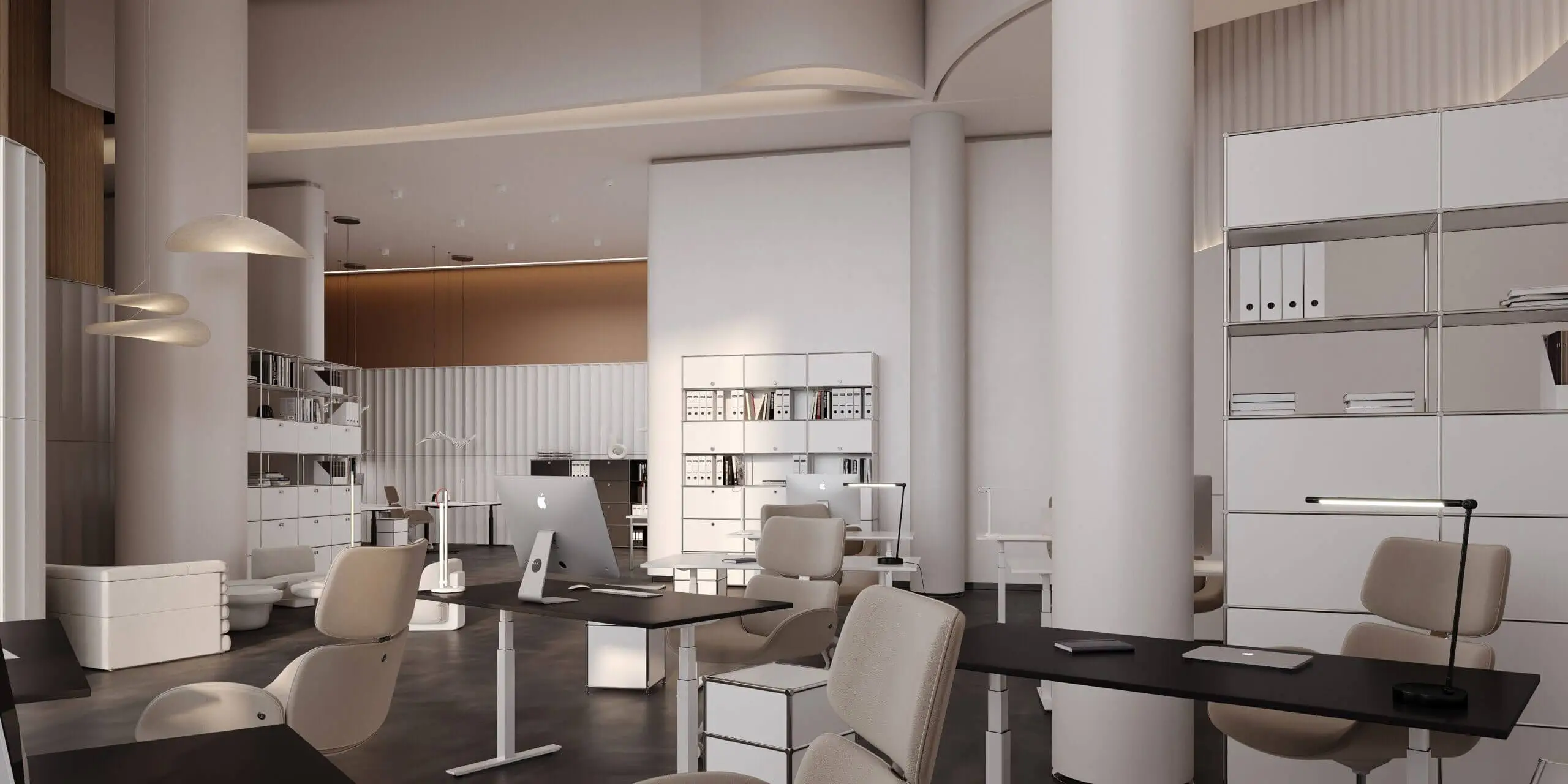
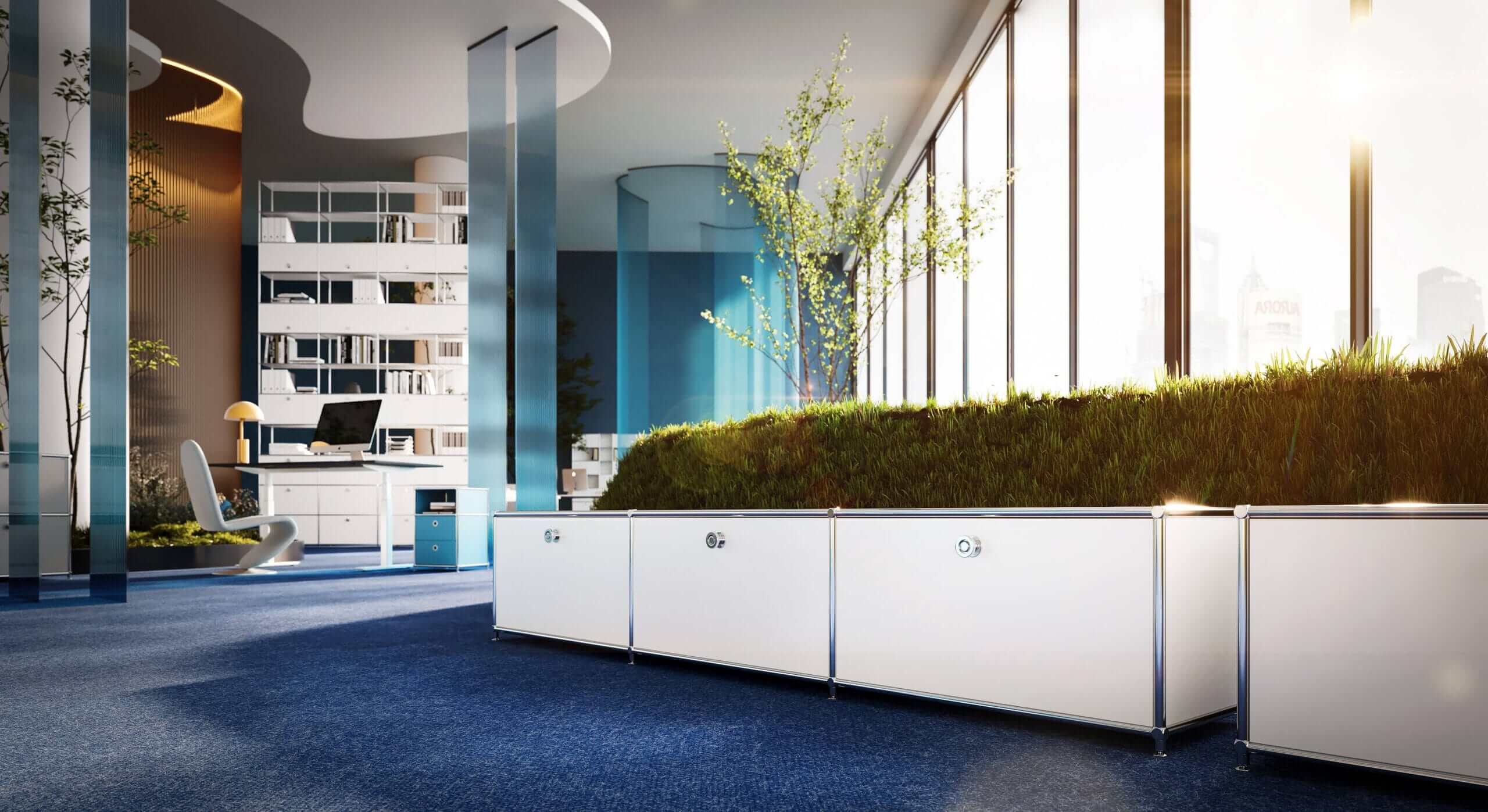

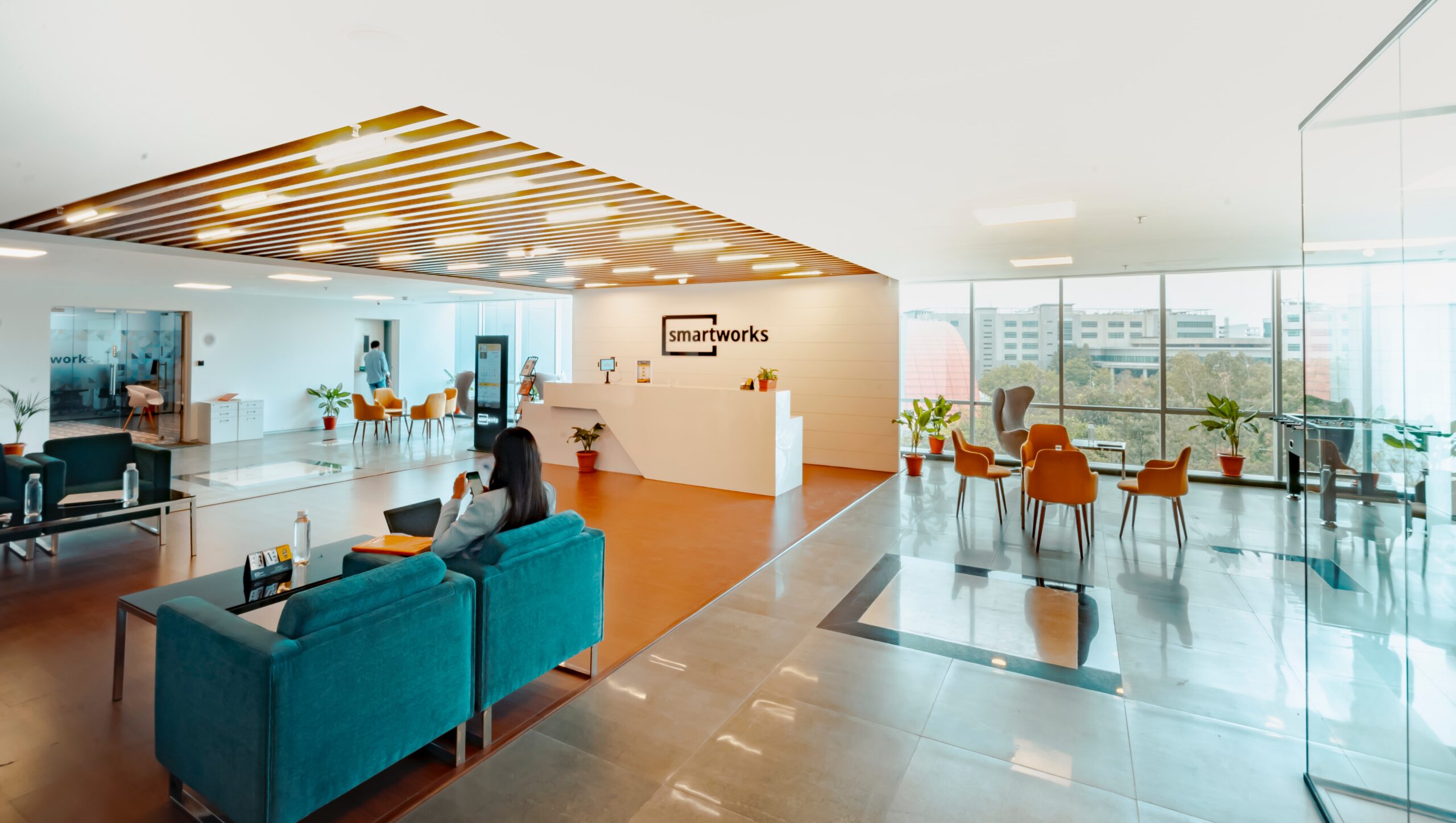

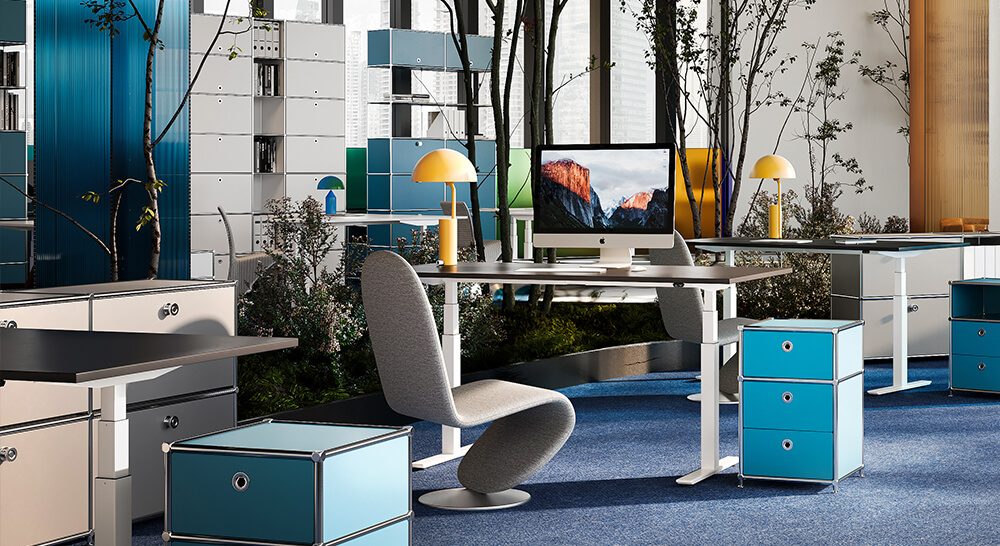
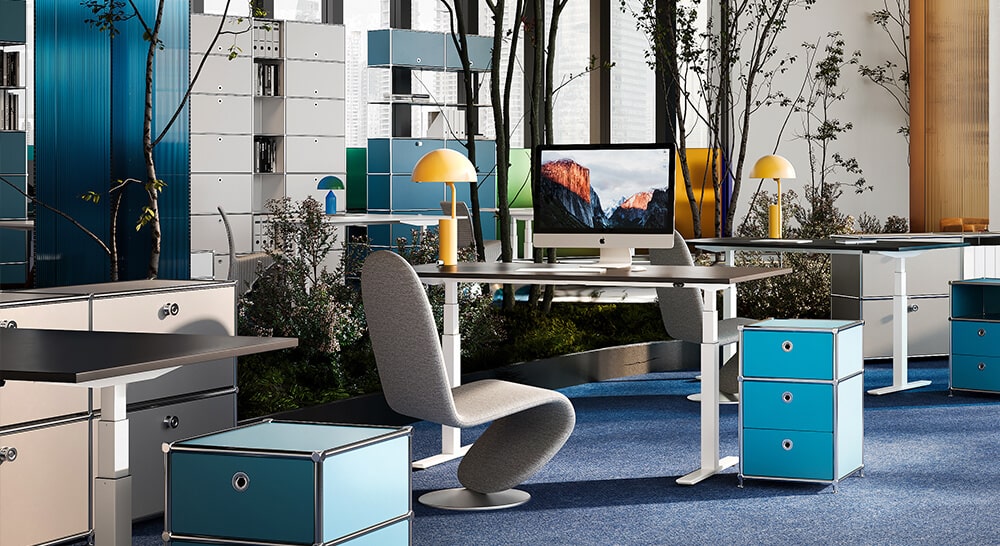


For more ideas, see the following link: https://flexcube.de/projekte/
Checklist Office furnishings
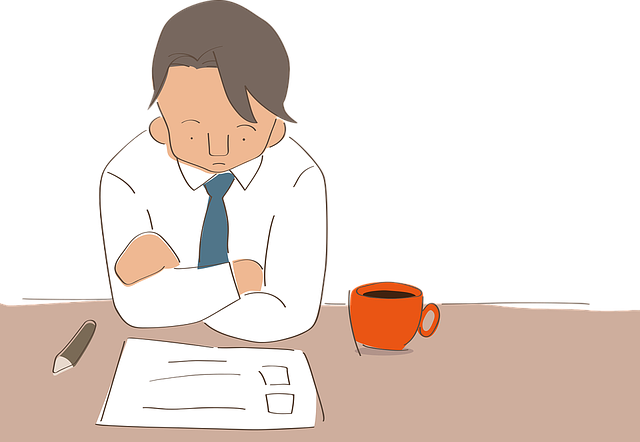
Congratulations – you have mastered all important steps of successful office furnishings. We have summarized the most important points again for you in this checklist.
- Listing of all areas that the office should include:
Entrance area, work areas, meeting rooms, social rooms, archive, etc. - Employees are informed and integrated into the processes as far as possible
- The arrangement of the areas on the surface minimizes walking distances and takes into account the functions of “concentrated individual work, collaboration, communication,
- The type of workstations: Individual workstation, team workstations, shared desks is defined
- Number, size, equipment of workstations is defined
- The necessary technical equipment is defined
Conclusion
This brings us to the end of our blog about office furniture . We hope you enjoyed learning about all the different elements that go into making a functional and stylish workplace. As we have seen, there are many factors to consider when decorating an office, from the layout of the room to the furniture and the color scheme. But with careful planning and a little creativity, you can design an office that meets your needs and reflects your company’s culture. Thank you for reading!
We hope you found these tips helpful. If you have any questions or would like to learn more about office furniture, please contact us. We are happy to help you design the perfect office for your business. Thank you very much!
Questions & answers about office furnishing
What do you need to furnish an office?
One of the most important things to consider when setting up an office is the design of the space. You need to make sure that you have enough space for all your employees and that they have enough workspace. A workplace should be a place where you feel comfortable and can work productively. You should be able to easily reach everything you need.
That’s part of a modern workplace:
- A spacious desk
- A comfortable desk chair
- Furniture for filing and archiving
- Laptop, personal computer with screen, keyboard, mouse
- Application programs and other software for the computer
- Technical equipment such as telephone system and printer
- Server or cloud storage
- Good lighting
- Storage space at the workplace
- Daylight
How do I set up a small office?
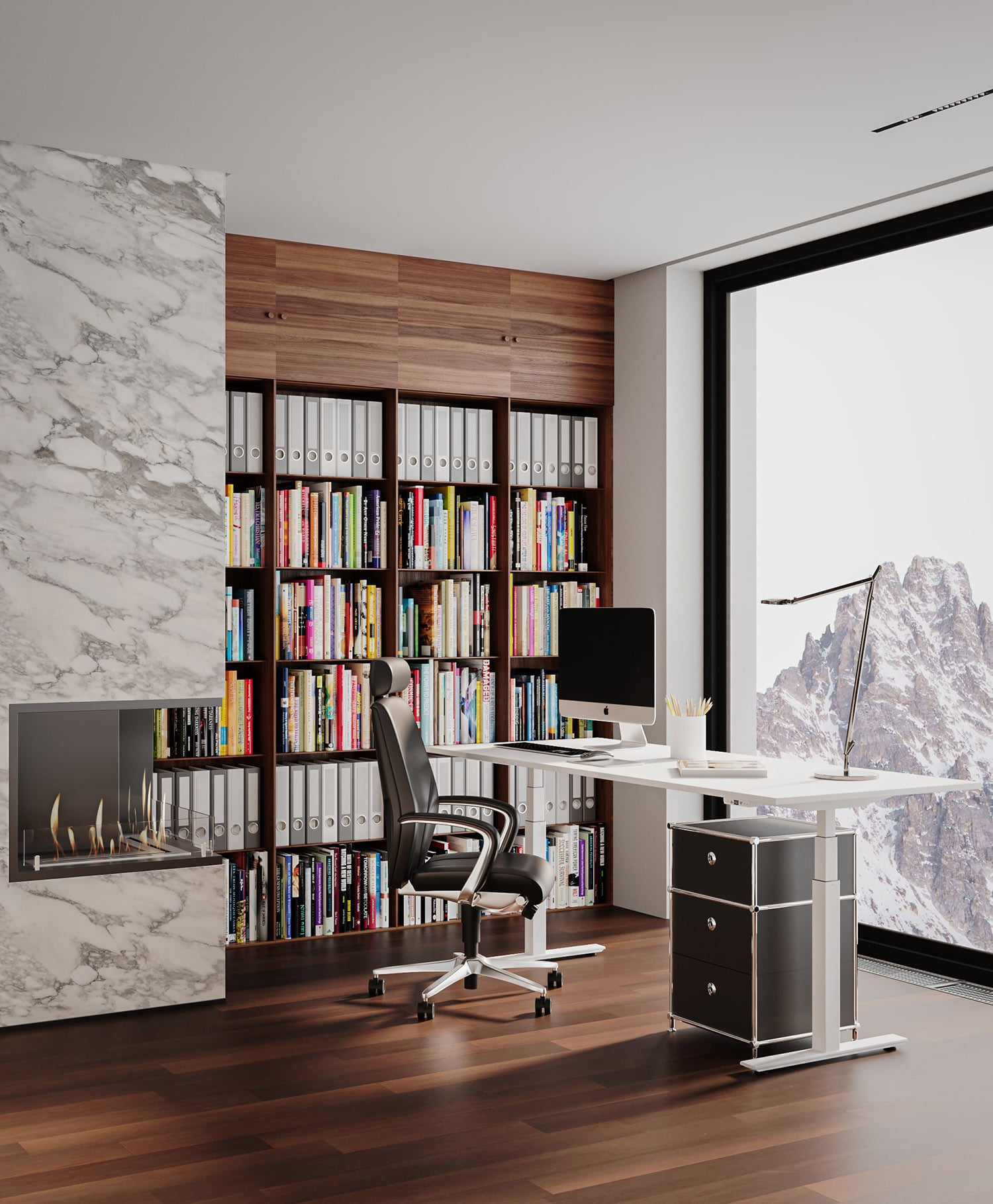
If a study has only a few square meters, it is important to use the height of the walls for storage space. Many cubic meters are achievable, even with only a few square meters. As a result, your everyday office life will be much more relaxed.
- Plan ceiling high storage space
- Store frequently used documents at easy to reach height levels. Rarely used documents further up.
- Open storage is suitable for storing files.
- Drawers with hanging files help to store many documents in a small space.
- Use large drawers on the lower level. Drawers provide a great overview of what is stored inside.
- Compartments with flaps are suitable for elegantly removing objects from view. Furthermore, the flaps provide additional working or storage space
- For small offices, desks with integrated storage or a drawer unit directly at or under the desk are the most suitable option. So you can easily store all the writing utensils and create space on the work surface of your desk.
- Choose multifunctional devices e.g. printer, scanner, copier in one. So you save a lot of space!
How to furnish a home office?
To be able to do office work at home is, a work surface and storage space form of course the basic equipement. A desk and shelves or closed storage can be easily placed in a separate room. Since the home office usually only has a small room available, the same criteria apply here as for setting up a small office.
If there is no separate room available or if work is only done at home on a few days, niches or unused roof slopes are also suitable for setting up a pleasant working area.
Even a sideboard can quite easily hide a small “office”.
The only prerequisite:
- a flap also about 75cm in height, which is the height of a normal desk
- A depth of 40cm to accommodate e.g. folders
You want to learn more?
Where is the best place to put a desk?
There are some “golden rules” you should follow:
- Ideally, a desk should be placed at a 90 degree angle to the window to avoid reflections on the screen.
- You should look into the room, not against a wall
- You should never have the door at your back, most people do not feel comfortable to be placed this way.
How do I set up a large office?
Planning and furnishing an open-plan office can be a very complex task that can easily overwhelm many business owners. The more employees and departments work in an open-plan office , the more important the professional preparation of a space, office and workstation plan becomes. These plans answer the questions: WHERE are which areas located in the office space? Where is work is done in individual offices or on team spaces? Are there shared desks in addition to fixed workspaces?
Large areas need clear spatial structures and subdivisions. A minimum
of privacy must also be guaranteed in any open-plan office to enable concentrated work.
A large number of workstations also always causes a relatively high noise level. Acoustic measures should be planned from the beginning.
Wie hat Ihnen der Artikel gefallen?
Auf die Sterne klicken, um zu bewerten.
Durchschnittliche Bewertung 0 / 5. Anzahl der Bewertungen: 0
Noch keine Bewertungen. Geben Sie die erste Bewertung ab.


